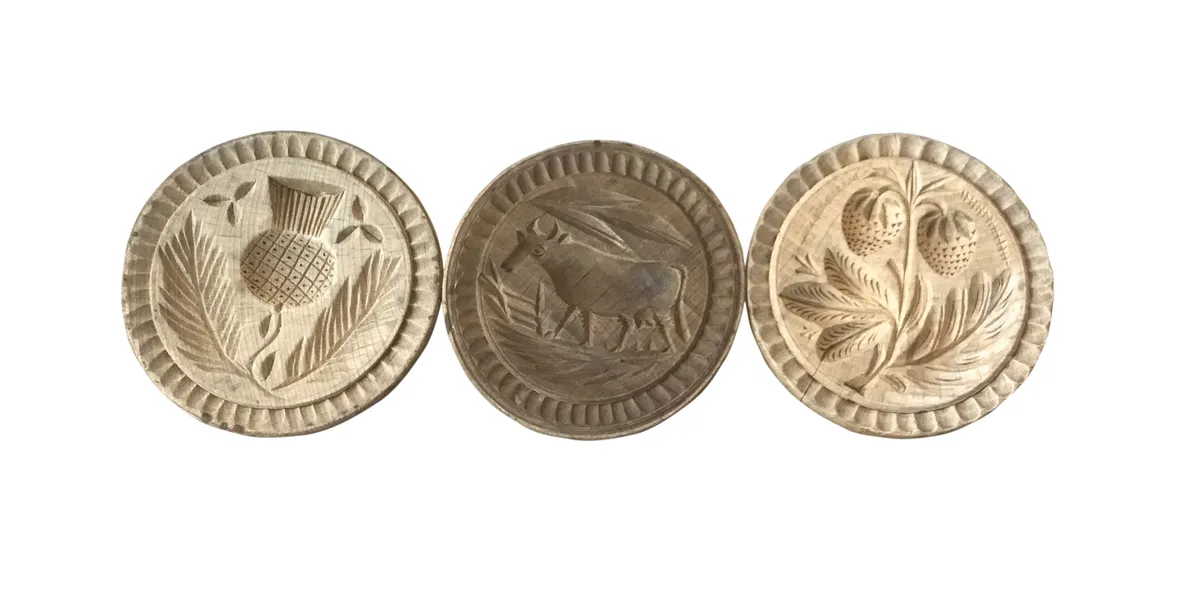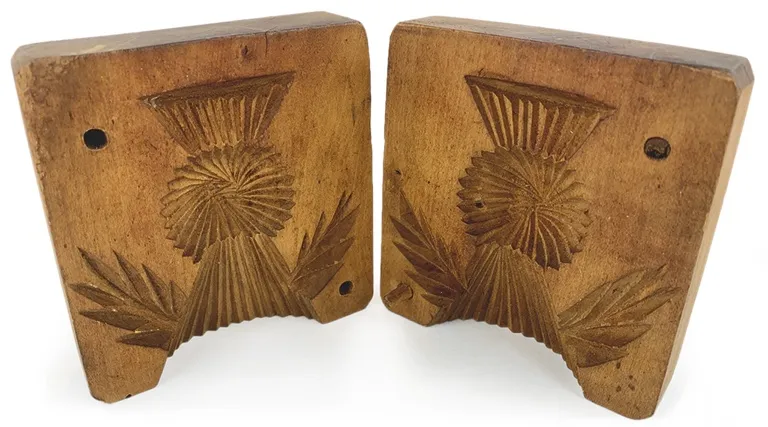The slap of the paddles, the traditional churning songs, the cool marble tiles of the dairy – there’s something so romantic about old-fashioned butter making and nothing more pleasing than a tray of fresh butter pats, imprinted with a pretty design.
Over recent years, antique butter moulds have become an exciting collecting field – and they make a beautiful addition to a traditional country kitchen.
What are antique butter moulds?
Butter moulds or stamps were used as early as Tudor times to decorate butter with images and words, but it was in the 19th century that they became incredibly popular, both in private kitchens to create attractive butter to decorate the table, and on farms to label and identify produce. They were one of the earliest forms of ‘trademark’. In commercial settings, moulds and stamps also served a practical purpose, demonstrating the consistency in the quantity sold.
Made of close-grained hardwoods such as holly, lime or (most commonly) sycamore, the name of the farmer and any decoration was carved into the stamp or mould in reverse so it would come out the correct way round when the butter pat was turned out. It was often popped out on a cabbage leaf, an early form of biodegradable packaging.
‘There are five different types of butter moulds,’ explains Sally Honey, treen expert and founder of Opus Antiques. ‘These are: single-piece flat prints (stamps); two-piece ‘ejector’ stamps (where the design is on a circle of wood with a handle, which acts like a plunger within a cylinder of wood to push the pressed pat out); two-piece moulds that push together (often held with small wooden pegs in holes) to create a three-dimensional butter decoration; rollers with patterns carved into them (like pastry rollers, but for rolling around the sides of a block of butter); and cup or brick moulds, which are dome-shaped like little jelly moulds or shaped like hollow bricks for producing blocks of patterned butter.’
The majority of moulds and stamps on the market todaytend to be 19th-century or early20th-century. ‘I occasionally getan 18th-century one, but they’re extremely rare,’ says Sally.

Which antique butter moulds are the most collectable?
Sally has a treasured mould at home from the Pinto collection. ‘It’s decorated with an apple. It’s a lovely piece – one that I’ll never part with,’ says Sally. ‘Edward Pinto wrote the bible on treen and nearly all of his collection went to the Birmingham Museum & Art Gallery, so it’s a very special one.’
Collectors are always drawn to quirky, unusual pictorial designs – cows, thistles and sheaves of wheat are fairly common, but rarer ones can fetch big sums when they appear on the market. ‘I’ve sold elegant swan designs in the past (perhaps originating from riverside farms), I had a rare reindeer one once and an unusual sunflower stamp that had a removable handle – for easy storage, I assume,’ Sally says. ‘Sometimes, butter moulds and stamps were celebratory. You often see initials on them, carved for some special occasion.’
How much are antique butter moulds worth?
Sally currently has a beautiful 19th-century leaf-design stamp in stock for £65 and a 19th-century sycamore butter mould with carved flowers to the base for £68.
Rarer moulds and stamps can command higher prices. For example, Jonathan Biggs of J. Collins & Son currently has a late 18th-century Scandinavian birch brick-shaped butter mould in stock, with carved initials ‘E.N.D.’ and ‘M.T.D.’ on the base, dated 1793, for £220.
Two-part moulds for creating three-dimensional butter shapes are rare and always highly sought after, too. Mike Witts of Appleby Antiques has a lovely two-part beechwood wheatsheaf mould in stock, c1820, for £285.

How to care for antique butter moulds
When buying a stamp or mould, look out for woodworm holes and splits, which might have been mended. A reputable dealer will always clearly highlight any repairs. ‘Butter moulds and stamps were used in hot kitchens and constantly washed, so they’re prone to splitting,’ says Sally.
An excerpt from Mrs Beeton’s Book of Household Management reveals the harsh life that butter stamps and moulds were subjected to: ‘Round butter moulds or wooden stamps are much used and are made in a variety of patterns. They should be kept scrupulously clean and, before the butter is pressed in, the moulds should be scalded, and afterwards soaked well in cold water. The butter at once takes the impress of the mould, and may therefore be turned out immediately into the butter dish.’
Where to buy antique butter moulds
- Appleby Antiques
- J. Collins & Son
- Opus Antiques
- The Antique Dispensary
- The Vintage Kitchen Store
- Tim Bowen Antiques
Where to see antique butter moulds
- Snowshill Manor and Garden, Gloucestershire
Head here to see a huge collection of butter moulds and stamps including one with a squirrel design, a rectangular one with ‘VALLEY FARM DAIRY’ carved into it and an ejector mould with a dainty strawberry plant pattern.
- Birmingham Museum & Art Gallery, Birmingham
The museum holds an impressive 8,044 items of treen from all over the world, including the important Pinto collection.
Words: Ellie Tennant
